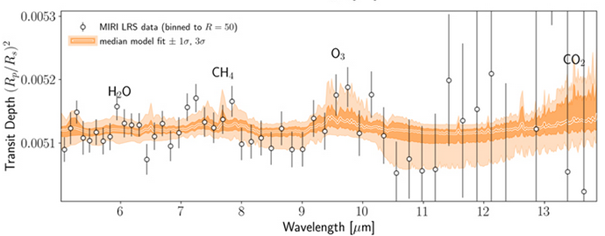James Webb could Detect Terrestrial Life Signatures from Across the Milky Way

Since its launch in late 2021, the James Webb Space Telescope (JWST) has revolutionized our view of the universe, giving us unprecedented details of distant galaxies and stars. In our pursuit to answer some of the most profound questions, we must not only marvel at the telescope's capabilities but also comprehend its constraints. One lingering question highlights such a limitation: Can the telescope detect the subtle hints of life, known as biosignatures, in the atmospheres of distant exoplanets?
In a recently published paper, Lustig-Yaeger et al utilized stellar occultation data from a transiting Earth. This method involves gathering atmospheric data when an exoplanet passes in front of its host star, with the planet's atmosphere acting as a filter, selectively scattering, absorbing, and transmitting light. This data was used to determine whether our current methods and technology would be able to identify life on our planet from afar.
To do this, the team used atmospheric models to construct an accurate 1D transmission spectrum, the kind most used to investigate the atmospheric composition of exoplanets. The process was repeated to obtain both high- and low-resolution models in the range of 3 - 14 µm.

Using these empirical models, the team then utilized the PandExo noise model, a tool specifically designed to simulate JWST observations by introducing synthetic noise and compression to the spectrum, to recreate the spectrum at an observing distance of ~40 ly. Specifically, the team attempted to simulate the spectrum if it were located within the TRAPPIST-1 system, a red dwarf system known to be home to 7 exoplanets. This system was selected due to both its proximity to Earth and because many of its planets are believed to be within the star’s habitable zone.
Finally, the team made use of their own exoplanetary atmospheric retrieval model, known as SMARTER, in an attempt to reproduce the Earth spectrum as best they could from their synthetic spectroscopic data.

Excitingly, they managed to identify all the spectroscopic signatures corresponding to key atmospheric biosignatures; H2O, CO2, O3, CH4, N2, N2O, NO2, HNO3. Additionally, they identified two so-called technosignatures, CFC-11 and CFC-12, which are indicative of Earth's technological advancements as these are human-made chemicals not found naturally. Furthermore, their models allowed for the relatively accurate derivation of various mixing ratios, with the first seven of these found to be within 28% of average Earth values. While the team tested their methodology by modelling a system 40 ly away, they believe that the JWST would be able to reliably identify the notable bio- and technosignatures within atmospheres as far as 50 ly away. This would place an estimated 4000 exoplanets within the necessary range to identify life based solely off atmospheric composition.
While this suggests that if life exists within this bubble of the Milky Way, a concern the authors of the paper raise is its inherent simplicity. This is primarily because we recognize the signatures indicative of life on Earth and understand the human impact on our atmosphere. However, there's no guarantee that other exoplanets will share the same signatures. Determining the presence of life on a planet will require contextual knowledge of the conditions under which life on other planets might have developed, raising the possibility that we could overlook significant discoveries because they'd be associated with unexpected compounds.
The recent study by Lustig-Yaeger et al. demonstrates the impressive potential of the JWST in capturing exoplanetary atmospheres up to 50 light-years away. Successfully identifying key markers from a synthetic Earth-like spectrum, the research offers a promising approach for the search for life beyond our solar system. However, the complexities of extraterrestrial conditions warn of potential oversights, emphasizing the need for a broader understanding of life's diverse manifestations in the universe.
--
Journal Source: J. Lustig-Yaeger et al, Earth as a Transiting Exoplanet: A Validation of Transmission Spectroscopy and Atmospheric Retrieval Methodologies for Terrestrial Exoplanets, The Planetary Science Journal, Vol. 4, No. 9, DOI: 10.3847/PSJ/acf3e5, 2023
Additional Reference: E. Macdonald and N. Cowan, Earth's transit spectrum from Macdonald and Cowan, Zenodo, DOI:10.5281/zenodo.8280710, 2019
